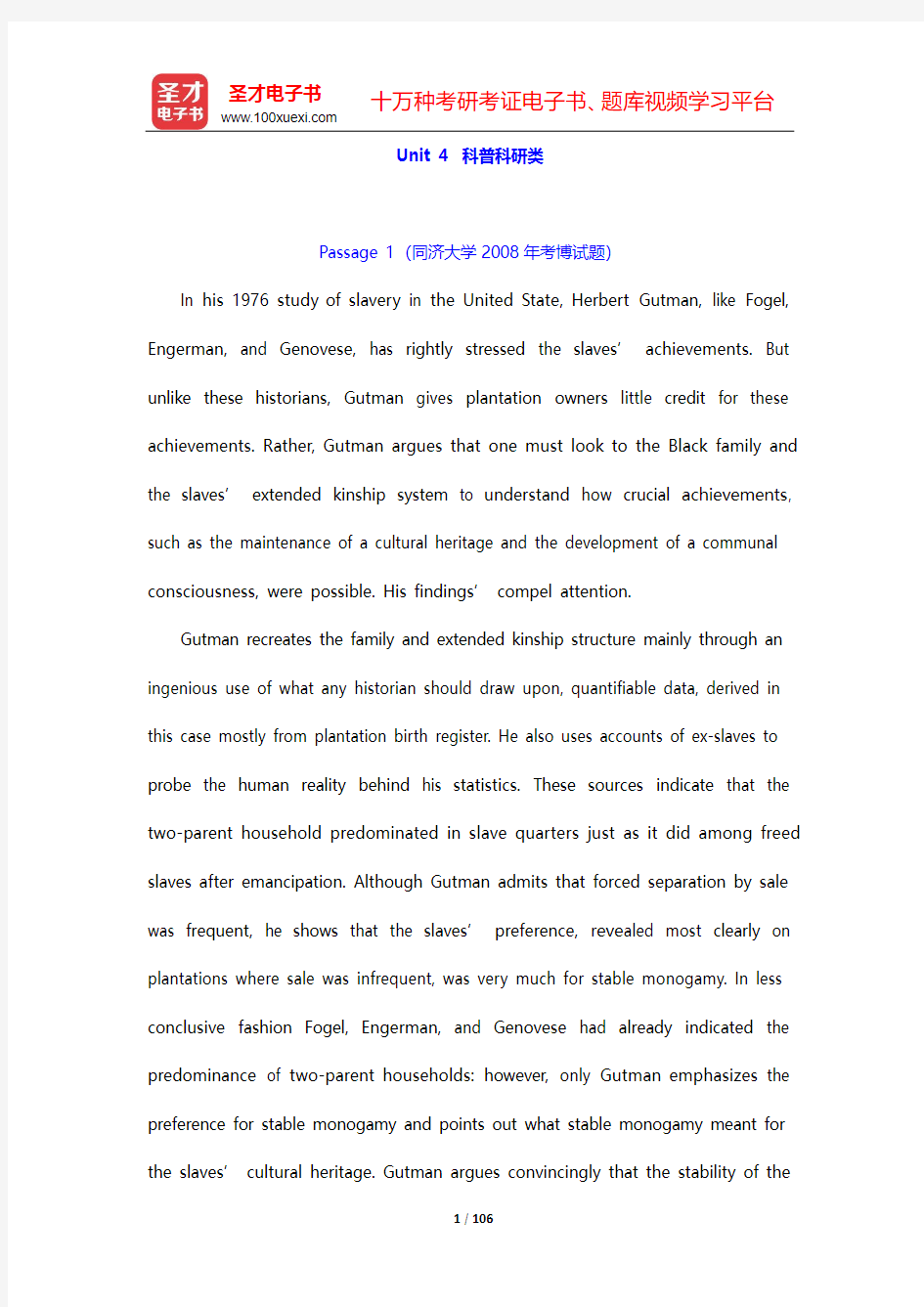考博英语阅读理解试题分类解析-阅读理解分类解析-Unit 4 科普科研类【圣才出品】

- 1、下载文档前请自行甄别文档内容的完整性,平台不提供额外的编辑、内容补充、找答案等附加服务。
- 2、"仅部分预览"的文档,不可在线预览部分如存在完整性等问题,可反馈申请退款(可完整预览的文档不适用该条件!)。
- 3、如文档侵犯您的权益,请联系客服反馈,我们会尽快为您处理(人工客服工作时间:9:00-18:30)。
Unit 4 科普科研类
Passage 1(同济大学2008年考博试题)
In his 1976 study of slavery in the United State, Herbert Gutman, like Fogel, Engerman, and Genovese, has rightly stressed the slaves’ achievements. But unlike these historians, Gutman gives plantation owners little credit for these achievements. Rather, Gutman argues that one must look to the Black family and the slaves’ extended kinship system to understand how crucial achievements, such as the maintenance of a cultural heritage and the development of a communal consciousness, were possible. His findings’ compel attention.
Gutman recreates the family and extended kinship structure mainly through an ingenious use of what any historian should draw upon, quantifiable data, derived in this case mostly from plantation birth register. He also uses accounts of ex-slaves to probe the human reality behind his statistics. These sources indicate that the two-parent household predominated in slave quarters just as it did among freed slaves after emancipation. Although Gutman admits that forced separation by sale was frequent, he shows that the slaves’ preference, reve aled most clearly on plantations where sale was infrequent, was very much for stable monogamy. In less conclusive fashion Fogel, Engerman, and Genovese had already indicated the predominance of two-parent households: however, only Gutman emphasizes the preference for stable monogamy and points out what stable monogamy meant for the slaves’ cultural heritage. Gutman argues convincingly that the stability of the
Black family encouraged the transmission of—and so was crucial in sustaining—the Black heritage of folklore, music, and religious expression from one generation to another, a heritage that slaves were continually fashioning out of their African and American experiences.
Gutman’s examination of other facets of kinship also produces important findings. Gutman discovers that cousins rarely married an exogamous tendency that contrasted sharply with the endogamy practiced by the plantation owners. This preference for exogamy, Gutman suggests, may have derived from West African rules governing marriage, which, though they differed from one tribal group to another, all involved some kind of prohibition against unions with close kin. This taboo against cousins’ marring is important, argues Gutman, because it is one of many indications of a strong awareness among slaves of an extended kinship network. The fact that distantly related kin would care for children separated from their families also suggests this awareness. When blood relationship were few as in newly created plantations in the Southwest, “fictive” kinship arrangements took their place until a new pattern of consanguinity developed. Gutman presents convincing evidence that this extended kinship structure—which he believes developed by the mid-to-late eighteenth century—provided the foundations for the strong communal consciousness that existed among slaves.
In sum, Gutman’s study is significant because it offers a closely reasoned and original explanation of some of the slaves’ achievements, one that correctly
